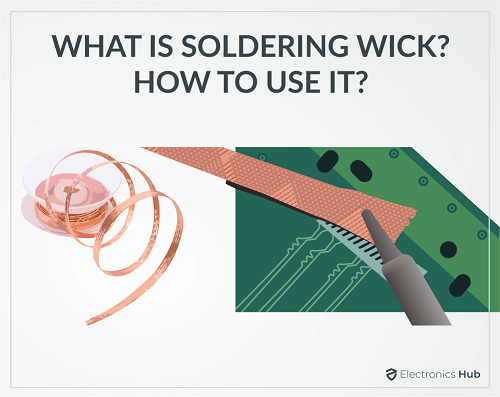The best thing about it is that – you do not need any specialized equipment to perform desoldering using the soldering wick method. Either you are an experienced person or a beginner, the soldering wick technique will serve you the purpose of desoldering. Soldering wick, also known as desoldering braid, is a type of desoldering method to remove solder and disassemble electrical components. The following article goes into detail about soldering wick and how to perform desoldering using it. Besides, the article also highlights the pros and cons of soldering wick.
What is Soldering Wick?
Soldering wick comes in a coil with strands of copper wire braided together. And, hence the name, desoldering braid.Since copper is a good conductor of heat and solder is attracted to heat, heating up the copper braid sucks the solder from the metal. Some desoldering braids come with flux to make the process of removing flux easier. If your desoldering braid does not have flux, you can apply the flux separately by dipping the tip of the braid into the flux.
How to Use Soldering Wick?
Soldering wick comes in very handy when you need to remove excess solder from a PCB. Especially if you are a beginner, having a soldering wick will help you correct your mistakes quickly. Before starting the desoldering process, you have to prepare yourself in the same manner when you solder metals. Wear protective gear, use an exhaust fan, and have a first aid kit ready. After that, follow the steps listed below to remove excess solder from the metal work piece.
Unwind a few inches of the braid. If your desoldering braid does not contain flux, you can add flux by dipping the end into the flux. Keep the braid over the joint. Hold a hot soldering iron against the braid for some time. You will notice the solder flows off from the joint and onto the braid. Detach the braid from the joint. Do not touch the braid with your hands as it will be very hot. Seapare the component. Repeat the same step for 4 to 5 times until you remove all the excess solder.
Benefits of Soldering Wick
Below are the benefits of using soldering wick to remove solder from the metal surface,
The process is very affordable It is simple and easy to use Soldering wick is available in different sizes depending on the amount of solder you want to remove It is ideal for removing solder from flat surfaces You can reuse the components
Disadvantages of Soldering Wick
Below are the disadvantages of using soldering wick,
You cannot reuse the desolder braid. You have to remove the used braid and start with a clean segment. It is difficult to hold the braid as it gets very hot. It is difficult to remove solder out of pin holes.
Conclusion
Soldering wick is one of the easiest methods to desolder a PCB and remove unwanted solder. The soldering wick consists of braids of intertwined copper wires. When you place the soldering wick against the solder and heat it, the soldering wick absorbs the solder due to its high thermal conductivity. By this way, you can remove the solder from the PCB or any metal surface. If you have any other doubts or queries, let us know using the comments section. Our team of experts will help you out. You can also post your thoughts and opinions in the comments box. Comment * Name * Email * Website
Δ






![]()